Mums, Chrysanths, Decorative Chrysanthemum, Pompon Chrysanthemum, Single Chrysanthemum, Double Chrysanthemum, Anemone Chrysanthemum, Quill Chrysanthemum, Spider Chrysanthemum, Irregular Incurve Chrysanthemum, Reflex Chrysanthemum, Regular Incurve Chrysanthemum, Intermediate Incurve, Spoon Chrysanthemum, Brush or Thistle Chrysanthemum, Exotic or Unclassified Chrysanthemum
Beloved for their late summer and fall flowers, Chrysanthemums or mums are terrific plants for adding color to borders and containers when most summer flowers have faded. Usually easy to grow, these fall garden favorites come in a wide range of colors, shapes, and sizes. They make wonderful, long-lasting cut flowers, too. While the Chrysanthemum genus includes about 40 species, countless horticultural varieties and cultivars are available.
Chrysanthemum blooms are composed of many tiny flowers called florets. Some have both disk and ray florets in the bloom heads, but others lack ray or disk florets. The National Chrysanthemum Society divides bloom forms into 13 classes, from single daisies to multi-petalled pompons, petite to giant blooms. Their spectacular flowers come in many colors, from pink, purple, and red, to orange, yellow, and white.
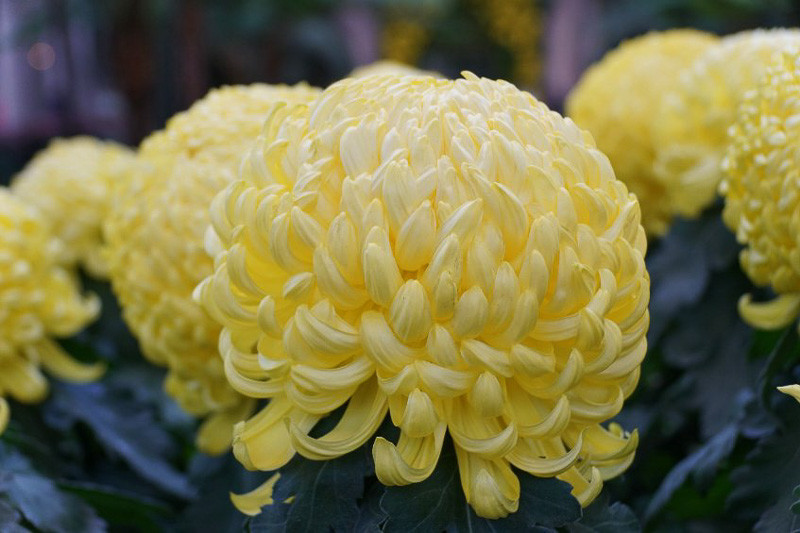
These chrysanthemums are the giant blooms of the Chrysanthemum genus. Many flowers are 6 to 8 inches across (15-20 cm). The florets (petals) are loosely incurve and make fully closed centers. The lower florets may droop and provide a skirted look. They need to be staked. They are mid-season bloomers (October). Represented above is the irregular incurve bloom of Chrysanthemum ‘King’s Pleasure’.
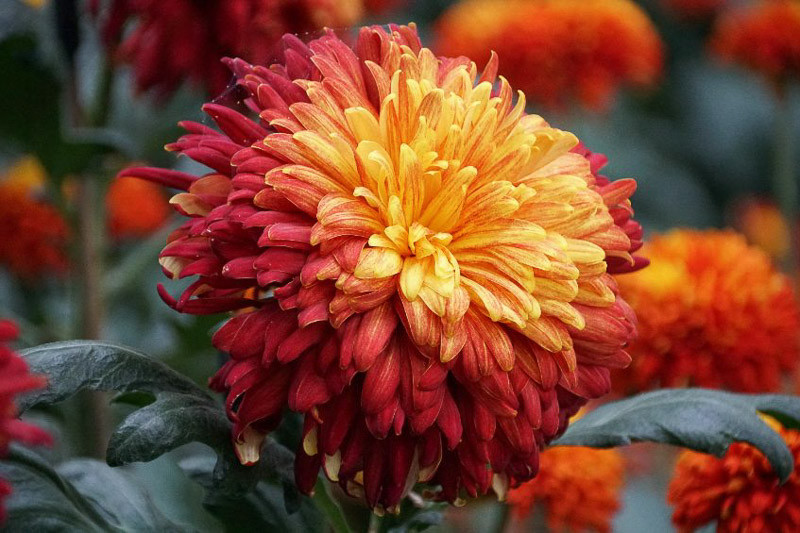
These chrysanthemums display large to medium-large flowers. The flowers can reach 4 to 6 inches in diameter (10-15 cm). Their florets curve downward and overlap, similar to bird plumage. The tops of these blooms are full but somewhat flattened. They need to be staked. They are early-season bloomers (September). Represented above is the Chrysanthemum ‘King George’ reflex flower form.
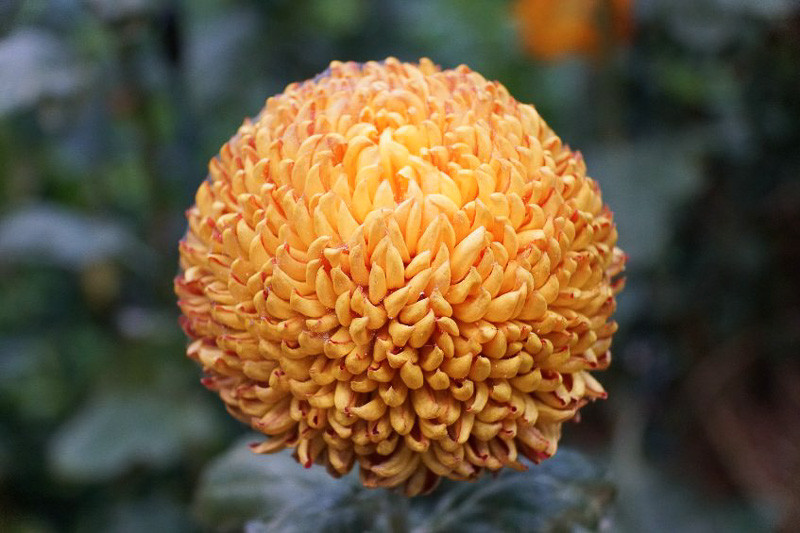
These Chrysanthemums display large to medium-large globular blooms equal in breadth and depth. The flowers can reach 4 to 6 inches in diameter (10-15 cm). Their florets smoothly incurve and form a regular ball. They need to be staked. They are mid-season bloomers (October). The Chrysanthemum ‘Heather James’ is represented above with beautiful deep reddish bronze flowers.
These Chrysanthemums display large to medium-large flattened full blooms with upper florets that tend to incurve while the lower petals are generally reflex. They make good cut flowers and garden mums. They may need support. They are early and mid-season bloomers (September, October). Award-winning Chrysanthemum ‘Grandchild’ is a neat, bushy perennial mum with double, reflexed, mauve-pink flowers produced in early to mid-fall.
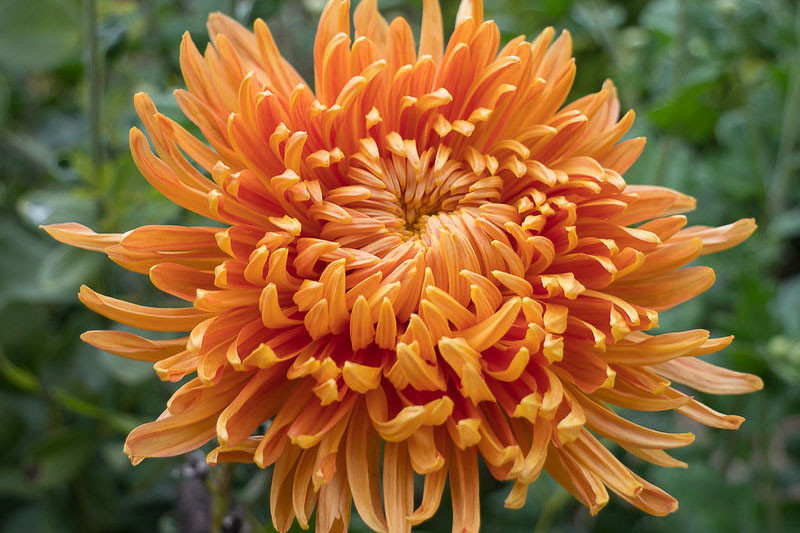
These Chrysanthemums display large to medium-large blooms, smaller than the irregular incurve Chrysanthemums, with shorter florets only partially incurving, giving a more loose open appearance. They may need support. They are early and mid-season bloomers (September, October). Represented above is Chrysanthemum ‘Cheerleader with large brushed amber blooms, 5-6 inches wide (12-15 cm), on a tall sturdy plant (up to 36 in. or 90 cm). A hardy perennial mum (hardiness zones 5-9).
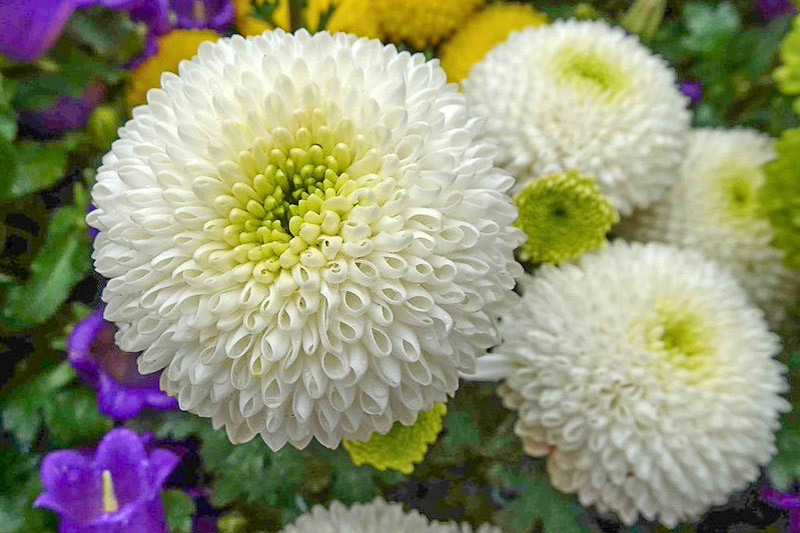
These Chrysanthemums display a profusion of small globular blooms, somewhat flat when young but fully rounded when mature. Regarding size, they range from small miniature buttons to large ball-shaped blooms almost 4 inches (10 cm) in diameter. The florets incurve or reflex regularly and fully conceal the center. They make good cut flowers and do not need support. They are mid-season bloomers (October). A popular variety is Chrysanthemum ‘Moonbeam, a charming mum of perfect pompon form with solid white blooms that can reach 4 inches across (10 cm).
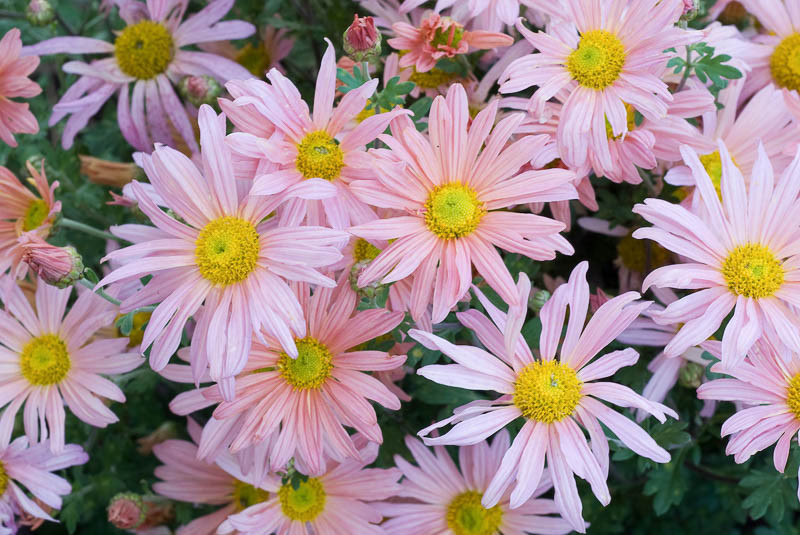 Reminiscent of daisy flowers, these Chrysanthemums produce flowers with a center disk and one or more rows of ray petals. They are mid-season bloomers (October). Clara Curtis is a ravishing single Chrysanthemum variety. An old and reliable selection of Mum, this free-flowering garden mum features a profusion of rose-pink, single and semi-double flowers, 2-3 in. across (5-7 cm). A truly hardy perennial mum (hardiness zones 4-9).
Reminiscent of daisy flowers, these Chrysanthemums produce flowers with a center disk and one or more rows of ray petals. They are mid-season bloomers (October). Clara Curtis is a ravishing single Chrysanthemum variety. An old and reliable selection of Mum, this free-flowering garden mum features a profusion of rose-pink, single and semi-double flowers, 2-3 in. across (5-7 cm). A truly hardy perennial mum (hardiness zones 4-9).
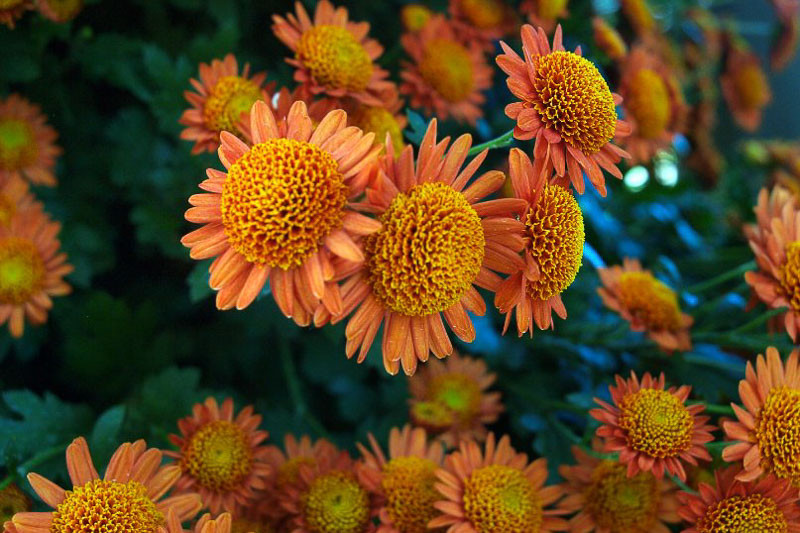
These Chrysanthemums produce large or small flowers similar to the semi-double Chrysanthemums but display a raised cushion-like center. They may need support. They are mid-season bloomers (October). A popular variety is Daybreak with large apricot orange anemone blooms adorned with a conspicuous orange cushion.
These Chrysanthemums resemble semi-double Chrysanthemums, except that their ray florets are like spoons at the tips. They produce large or small flowers with a round and visible center disk. They are mid-season bloomers (October). Adding brilliance to the late-season garden, Chrysanthemum ‘Matchsticks’ is a hardy garden mum sporting profuse and showy flowers featuring spoon-shaped golden-yellow petals adorned with fiery red tips. Blooming from early to mid-fall, this perennial forms a compact, bushy, upright clump and does not require staking. Easy to grow, it is an excellent choice for sunny borders or containers. Hardiness zones 5-9.
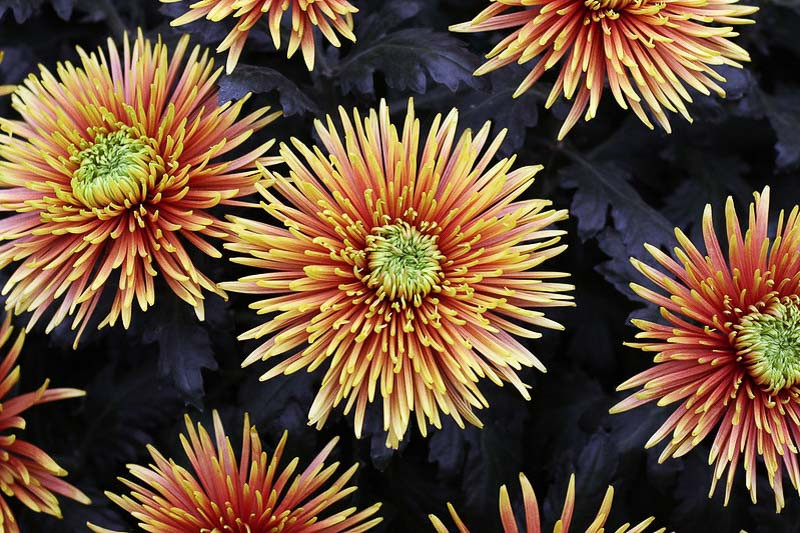
These Chrysanthemums produce large or small, fully double flowers with straight and tubular florets with open tips. They are mid-season bloomers (October). Chrysanthemum ‘Saffina’ is a spectacular, vibrant quill with fiery orange florets adorned with yellow tips and a bright green center. Wonderful in bouquets and floral arrangements.
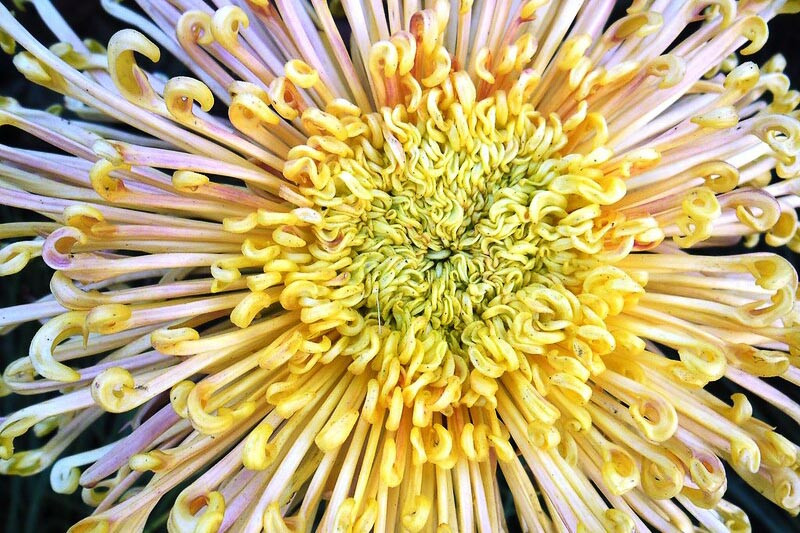 Exotic-looking, these Chrysanthemums produce large flowers with thin thread-like florets that may coil or hook at the ends. They are mid-season bloomers (October). Chrysanthemum ‘Mocha’ is a pretty spider mum, with pink florets that are exceptionally thin, long, and elegant.
Exotic-looking, these Chrysanthemums produce large flowers with thin thread-like florets that may coil or hook at the ends. They are mid-season bloomers (October). Chrysanthemum ‘Mocha’ is a pretty spider mum, with pink florets that are exceptionally thin, long, and elegant.
Resembling an artist’s paintbrush or a thistle, these Chrysanthemums produce medium-large blooms with fine tubular florets that grow parallel to the stem or flattened, twisted, and drooping. Great for flower arrangements. They are mid-season bloomers (October).
These Chrysanthemums do not fit in any of the other classes.
| Hardiness |
5 - 9 |
|---|---|
| Heat Zones |
5 - 9 |
| Climate Zones | 2, 2A, 2B, 3, 3A, 3B, 4, 5, 6, 7, 8, 9, 10, 11, 12, 13, 14, 15, 16, 17, 18, 19, 20, 21, 22, 23, 24, H1 |
| Plant Type | Annuals, Perennials, Shrubs |
| Genus | Chrysanthemum |
| Exposure | Full Sun |
| Season of Interest |
Summer (Late) Fall |
| Maintenance | Average |
| Water Needs | Average |
| Soil Type | Clay, Loam, Sand |
| Soil pH | Acid, Alkaline, Neutral |
| Soil Drainage | Moist but Well-Drained |
| Characteristics | Cut Flowers, Showy |
| Attracts | Butterflies |
| Landscaping Ideas | Patio And Containers, Beds And Borders |
| Garden Styles | City and Courtyard, Cutting Garden, Informal and Cottage, Traditional Garden |
Rohan Singh, Tanya Hart, 阿橋 HQ, Flickr, 123rf
| Hardiness |
5 - 9 |
|---|---|
| Heat Zones |
5 - 9 |
| Climate Zones | 2, 2A, 2B, 3, 3A, 3B, 4, 5, 6, 7, 8, 9, 10, 11, 12, 13, 14, 15, 16, 17, 18, 19, 20, 21, 22, 23, 24, H1 |
| Plant Type | Annuals, Perennials, Shrubs |
| Genus | Chrysanthemum |
| Exposure | Full Sun |
| Season of Interest |
Summer (Late) Fall |
| Maintenance | Average |
| Water Needs | Average |
| Soil Type | Clay, Loam, Sand |
| Soil pH | Acid, Alkaline, Neutral |
| Soil Drainage | Moist but Well-Drained |
| Characteristics | Cut Flowers, Showy |
| Attracts | Butterflies |
| Landscaping Ideas | Patio And Containers, Beds And Borders |
| Garden Styles | City and Courtyard, Cutting Garden, Informal and Cottage, Traditional Garden |
Create a membership account to save your garden designs and to view them on any device.
Becoming a contributing member of Gardenia is easy and can be done in just a few minutes. If you provide us with your name, email address and the payment of a modest $25 annual membership fee, you will become a full member, enabling you to design and save up to 25 of your garden design ideas.
Join now and start creating your dream garden!
Create a membership account to save your garden designs and to view them on any device.
Becoming a contributing member of Gardenia is easy and can be done in just a few minutes. If you provide us with your name, email address and the payment of a modest $25 annual membership fee, you will become a full member, enabling you to design and save up to 25 of your garden design ideas.
Join now and start creating your dream garden!